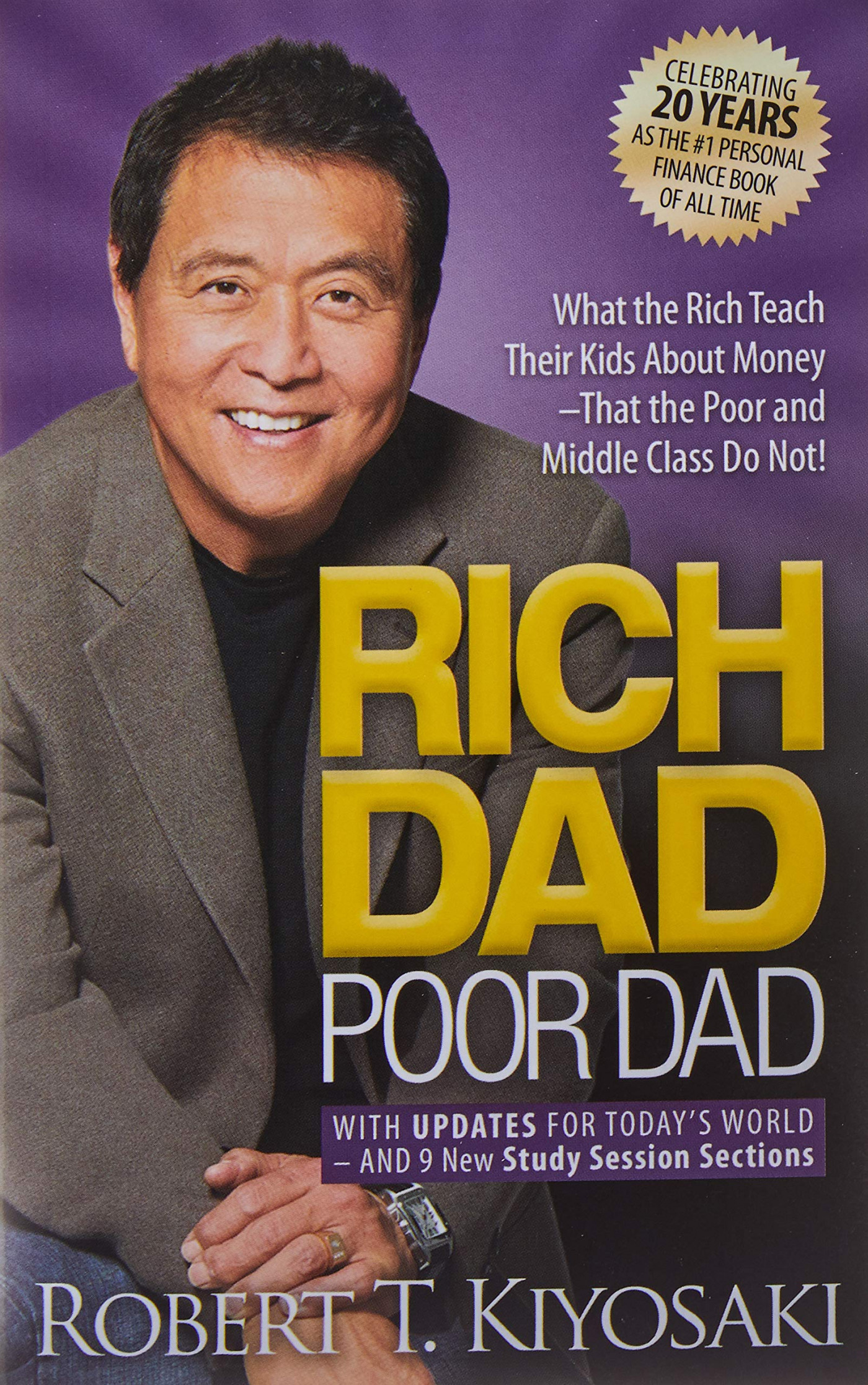“Rich Dad Poor Dad” by Robert T. Kiyosaki is a widely acclaimed New York Times Best Seller that has left a lasting impact on its readers since its initial publication in 1997. The book delves into the author’s upbringing, where he was influenced by two father figures with contrasting financial philosophies. Through rich anecdotal narratives, Kiyosaki imparts essential lessons about wealth accumulation and financial literacy. The book’s insights on assets, liabilities, and the stark differences in the financial strategies of the rich, the middle class, and the poor make it a compelling read for anyone seeking to gain a deeper understanding of wealth creation and management.
Understanding the Basics of “Rich Dad Poor Dad”
Before delving into a book review of “Rich Dad Poor Dad,” it’s essential to understand its core concepts. The book presents a compelling perspective on personal finance and investment, narrated through the contrasting experiences of two influential figures in the author’s life.
Overview of the Book’s Concept
“Rich Dad Poor Dad” by Robert Kiyosaki revolves around financial education and the mindset required to attain financial independence. Kiyosaki challenges conventional beliefs about money and introduces unique insights into accumulating wealth. Through anecdotal storytelling, he imparts invaluable lessons that redefine the traditional approach to finances, urging readers to adopt a more strategic and proactive mindset.
The Two Fathers
The narrative unfolds around the author’s two influential father figures: his biological father, referred to as the “Poor Dad,” and the father of his childhood best friend, known as the “Rich Dad.” The divergent financial philosophies and contrasting life paths of these two individuals serve as the foundation for Kiyosaki’s teachings. While the “Poor Dad” represents conventional employment and a cautious approach to money, the “Rich Dad” embodies entrepreneurial spirit and astute investment strategies.

Photo by Tamiles Esposito
Key Financial Lessons from “Rich Dad Poor Dad”
The book “Rich Dad Poor Dad” by Robert Kiyosaki presents valuable financial lessons that have the potential to transform one’s perspective on wealth and success.
The Importance of Financial Education
 Photo by Mikhail Nilov
Photo by Mikhail Nilov
Financial education is emphasized as an essential tool for achieving financial independence. Kiyosaki advocates that true power lies in understanding the principles of money management and investing rather than relying solely on traditional education.
The Power of Investing
The author emphasizes the significance of making money work for individuals. He underscores the difference between the mindset of the rich, who focus on building and diversifying their investments, and the middle class, who often rely solely on earned income.
Building Assets vs. Acquiring Liabilities
“Rich Dad Poor Dad” highlights the fundamental disparity between assets and liabilities. It underscores the need to prioritize building assets that generate income, such as businesses and real estate, over acquiring liabilities, which deplete financial resources.
The book urges readers to cultivate a mindset of wealth creation and strategic investment, ultimately leading to financial freedom and security.
Analyzing the Writing Style and Readability
Kiyosaki’s writing style in “Rich Dad Poor Dad” is defined by his adept use of anecdotes, which effectively illustrate financial principles and make the content relatable to readers. The book’s language is accessible, employing simple yet impactful vocabulary that ensures clarity and comprehension for readers at various literacy levels. Additionally, Kiyosaki’s writing style exhibits high lexical density, characterized by detailed and descriptive language that contributes to a sophisticated narrative style. This enriches the reading experience and presents complex financial concepts in an engaging manner, fostering a deeper understanding for the reader.
Kiyosaki’s Use of Anecdotes
 Photo by RF._.studio
Photo by RF._.studio
Kiyosaki effectively utilizes anecdotes throughout “Rich Dad Poor Dad,” weaving real-life experiences into the narrative to emphasize financial lessons and provide practical examples for readers. These anecdotes enhance the book’s readability by offering relatable scenarios that resonate with audiences, thereby reinforcing the underlying principles in a compelling manner.
Language and Accessibility for Readers
Kiyosaki employs accessible language in “Rich Dad Poor Dad,” utilizing a clear and straightforward writing style that accommodates readers across different literacy levels. The book’s language is crafted to ensure comprehension, enabling a wide audience to engage with the content and grasp the fundamental financial concepts presented. This approach fosters inclusivity and makes the book accessible to individuals seeking financial literacy, irrespective of their reading proficiency.
To further understand lexical density and diversity, particularly in financial writing, you may refer to the explanation provided by Readability Formulas.
Considering the theme of financial literacy, Kiyosaki’s use of anecdotes and accessible language enriches “Rich Dad Poor Dad,” making profound financial insights digestible for readers from diverse backgrounds. The combination of relatable storytelling and clear language fosters a compelling reading experience, aligning with the book’s objective of imparting valuable financial wisdom.
The Impact of “Rich Dad Poor Dad” on Personal Finance
“Rich Dad Poor Dad” has made a significant impact on personal finance by changing mindsets about money and sparking criticism and controversy.
Changing Mindsets About Money
The book challenges traditional beliefs about money management and encourages readers to adopt a more entrepreneurial mindset. It emphasizes the importance of financial education, investment, and creating passive income streams. The concepts presented in “Rich Dad Poor Dad” have influenced many to reevaluate their approach to personal finance, inspiring them to seek out opportunities for wealth creation and financial independence.
 Photo by Lukas
Photo by Lukas
Criticism and Controversy Surrounding the Book
Despite its popularity, “Rich Dad Poor Dad” has faced criticism and controversy. Some financial experts question the accuracy of the anecdotes and the effectiveness of the advice provided in the book. Additionally, there have been debates about the author’s background and the legitimacy of the teachings. However, these critiques have not diminished the book’s impact, as it continues to shape the perspectives of individuals seeking financial guidance.
Related Resources
- To explore more about the impact of financial education, visit Investopedia for comprehensive insights.
- Are you new to the world of investing? Feeling overwhelmed by the jargon and complex strategies? Look no further then this guide Enthusiastic Investing for Beginners: 11 Steps
The narrative of “Rich Dad Poor Dad” has prompted a shift in the way people perceive wealth and financial success, fueling discussions and encouraging individuals to take a proactive approach to managing their finances.
Real-Life Application of the Book’s Principles
“Rich Dad Poor Dad” has inspired numerous success stories in the realm of personal finance and entrepreneurship. Individuals who have followed the principles outlined in the book have not only achieved financial success but have also transformed their mindset about wealth and investment.
Success Stories Inspired by the Book
One notable success story inspired by “Rich Dad Poor Dad” is that of Robert Herjavec, a prominent entrepreneur and investor who credits the book for shaping his perspective on money management and real estate investments. His journey from being a waiter to becoming a multimillionaire reflects the transformative impact of the book’s teachings.
Another compelling example is the story of Danielle and Phil Town, a mother and son duo who attribute their financial prosperity to the fundamental lessons learned from the book. Their journey from financial struggle to achieving substantial wealth through strategic investment practices underscores the practical applicability of the book’s principles.
Challenges in Implementing Kiyosaki’s Advice
Despite the book’s profound insights, many individuals encounter challenges when implementing Kiyosaki’s advice. One common obstacle is the initial resistance to embracing a new approach to money management and investment. Overcoming ingrained habits and beliefs about wealth can be a significant hurdle for individuals seeking to apply the book’s principles in their lives.
Additionally, the volatile nature of the financial market presents a challenge for individuals striving to execute Kiyosaki’s investment strategies. Navigating the complexities of investment decisions and market fluctuations demands a comprehensive understanding of the principles advocated in the book, which can be daunting for those new to the world of finance.
Comparing “Rich Dad Poor Dad” to Other Financial Advice Books
When comparing “Rich Dad Poor Dad” to other personal finance guides, it’s important to acknowledge the similarities and unique insights offered by Robert Kiyosaki.
Similarities with Other Personal Finance Guides
“Rich Dad Poor Dad” shares the common goal of empowering individuals with the knowledge and mindset necessary to achieve financial independence. Like many financial advice books, it emphasizes the importance of financial literacy, strategic investment, and asset accumulation. However, what sets it apart is its unconventional approach to wealth building and its emphasis on shifting one’s perspective on money.
Unique Insights Offered by Kiyosaki
Robert Kiyosaki provides a distinct perspective on wealth accumulation and financial success. Unlike conventional wisdom, he challenges the traditional notions of wealth and offers unique insights into the mindset and behavior that differentiate the rich from the poor. Kiyosaki’s emphasis on financial education, asset acquisition, and passive income streams sets “Rich Dad Poor Dad” apart as a thought-provoking and innovative addition to the genre of personal finance literature.

Photo by Clem Onojeghuo
Who Should Read “Rich Dad Poor Dad”?
Rich Dad Poor Dad by Robert Kiyosaki is a compelling read for various individuals seeking to enhance their financial literacy and wealth-building skills.
Target Audience for the Book
Young Adults:
Young adults who are beginning their careers can benefit from the insights shared in “Rich Dad Poor Dad.” The book provides guidance on making wise financial decisions and establishing a robust foundation for future success.
 Photo by Thought Catalog
Photo by Thought Catalog
Entrepreneurs:
Small business owners and aspiring entrepreneurs can gain valuable insights into asset building and creating passive income streams to support business growth from the wisdom imparted in this book.
Benefits for Young Adults and Entrepreneurs
“Rich Dad Poor Dad” offers practical knowledge and inspiration for individuals navigating the early stages of their careers or entrepreneurial journeys. It challenges conventional financial beliefs and provides actionable advice on wealth creation. The book also emphasizes the significance of financial education and fosters a mindset focused on financial freedom and success.

Photo by David McEachan
Conclusion
In conclusion, “Rich Dad Poor Dad” by Robert T. Kiyosaki provides valuable insights into financial literacy, investment strategies, and the mindset needed to build wealth. The distinction between assets and liabilities, the importance of financial education, and the principles of building wealth are all key takeaways from this book. It’s a thought-provoking read that challenges traditional beliefs about money and offers a fresh perspective on wealth creation. Whether you’re new to the world of finance or a seasoned investor, the lessons shared in this book can spark a new approach to managing and growing your wealth.
